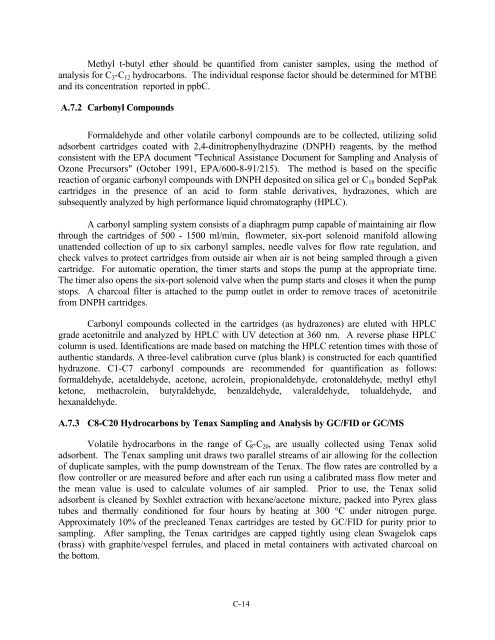Central California Ozone Study (CCOS) - Desert Research Institute
Central California Ozone Study (CCOS) - Desert Research Institute
Central California Ozone Study (CCOS) - Desert Research Institute
You also want an ePaper? Increase the reach of your titles
YUMPU automatically turns print PDFs into web optimized ePapers that Google loves.
Methyl t-butyl ether should be quantified from canister samples, using the method of<br />
analysis for C 3 -C 12 hydrocarbons. The individual response factor should be determined for MTBE<br />
and its concentration reported in ppbC.<br />
A.7.2 Carbonyl Compounds<br />
Formaldehyde and other volatile carbonyl compounds are to be collected, utilizing solid<br />
adsorbent cartridges coated with 2,4-dinitrophenylhydrazine (DNPH) reagents, by the method<br />
consistent with the EPA document "Technical Assistance Document for Sampling and Analysis of<br />
<strong>Ozone</strong> Precursors" (October 1991, EPA/600-8-91/215). The method is based on the specific<br />
reaction of organic carbonyl compounds with DNPH deposited on silica gel or C 18 bonded SepPak<br />
cartridges in the presence of an acid to form stable derivatives, hydrazones, which are<br />
subsequently analyzed by high performance liquid chromatography (HPLC).<br />
A carbonyl sampling system consists of a diaphragm pump capable of maintaining air flow<br />
through the cartridges of 500 - 1500 ml/min, flowmeter, six-port solenoid manifold allowing<br />
unattended collection of up to six carbonyl samples, needle valves for flow rate regulation, and<br />
check valves to protect cartridges from outside air when air is not being sampled through a given<br />
cartridge. For automatic operation, the timer starts and stops the pump at the appropriate time.<br />
The timer also opens the six-port solenoid valve when the pump starts and closes it when the pump<br />
stops. A charcoal filter is attached to the pump outlet in order to remove traces of acetonitrile<br />
from DNPH cartridges.<br />
Carbonyl compounds collected in the cartridges (as hydrazones) are eluted with HPLC<br />
grade acetonitrile and analyzed by HPLC with UV detection at 360 nm. A reverse phase HPLC<br />
column is used. Identifications are made based on matching the HPLC retention times with those of<br />
authentic standards. A three-level calibration curve (plus blank) is constructed for each quantified<br />
hydrazone. C1-C7 carbonyl compounds are recommended for quantification as follows:<br />
formaldehyde, acetaldehyde, acetone, acrolein, propionaldehyde, crotonaldehyde, methyl ethyl<br />
ketone, methacrolein, butyraldehyde, benzaldehyde, valeraldehyde, tolualdehyde, and<br />
hexanaldehyde.<br />
A.7.3 C8-C20 Hydrocarbons by Tenax Sampling and Analysis by GC/FID or GC/MS<br />
Volatile hydrocarbons in the range of C 8 -C 20 , are usually collected using Tenax solid<br />
adsorbent. The Tenax sampling unit draws two parallel streams of air allowing for the collection<br />
of duplicate samples, with the pump downstream of the Tenax. The flow rates are controlled by a<br />
flow controller or are measured before and after each run using a calibrated mass flow meter and<br />
the mean value is used to calculate volumes of air sampled. Prior to use, the Tenax solid<br />
adsorbent is cleaned by Soxhlet extraction with hexane/acetone mixture, packed into Pyrex glass<br />
tubes and thermally conditioned for four hours by heating at 300 °C under nitrogen purge.<br />
Approximately 10% of the precleaned Tenax cartridges are tested by GC/FID for purity prior to<br />
sampling. After sampling, the Tenax cartridges are capped tightly using clean Swagelok caps<br />
(brass) with graphite/vespel ferrules, and placed in metal containers with activated charcoal on<br />
the bottom.<br />
C-14
















